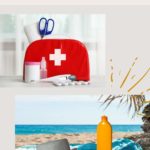A Basic Travel First Aid Kit


You can certainly buy a pre-packaged travel first aid kit.
Why make up your own first aid kit
But, after giving it a good deal of thought (and having a few cuts and scrapes over the years) I decided to make up my own kit for a couple of reasons: It’s ultimately cheaper than buying the pre-packaged variety; if I make it up myself, I know exactly what’s in it; and, as I use up supplies, I can easily replenish it either on the road or from the stores at home.
So, in other words, the best travel first aid kit is one you make up yourself.
So, based on my consultation with a registered nurse, here’s what’s in our homemade emergency travel first aid kit:
What goes in your first aid kit
1. Bandages, i.e. Band-Aids in various sizes:
Obviously, bandages are the first thing to go into your kit. Cuts and scrapes are the most common injury, so a dozen or so bandages in various sizes are your best bet.
2. Gauze pads: These are the next level after the Band-aids. You can use them to soak up blood, apply pressure to stop bleeding, clean a wound, or whatever else you need to do. For a larger wound, protect the wound with the gauze pad and tape it down with adhesive tape or Band-Aids.
3. Adhesive (athletic) tape: It’s good to carry a roll or two of medical adhesive tape to secure gauze if needed. This tape also is part of your blister kit, if you get those while hiking.
4. Small scissors: You can use these for cutting gauze and tape to the exact size you need. Be careful: depending on the scissors, you may have to check them when you fly so security doesn’t take them from you. The round nose versions are safer.
5. Elastic or crepe bandage: If you have something bigger than a small cut, you might need one of these to hold your gauze dressing(s) in place until you can get to medical help. Also, these are good for light sprains, and, again, will help until you can get to a more permanent solution.
6. Tweezers: We actually like both the slant nose and pointed versions, but you probably only really need to carry one. They’re good for splinters, and getting little bits of rock and other debris out of a wound. They also work for ticks, but be careful you remove them the right way.
7. Antiseptic wipes: Individutally wrapped antiseptic wipes are an essential precursor to clean a wound before applying your bandage or gauze.
8. Antiseptic (Neosporin) cream: A good idea for any cuts or scrapes to prevent infection. This is also an essential component of your blister kit.
9. Antihistamine or cortisone cream: Two words: insect bites. They aren’t dangerous, probably, but they’re annoying. These creams will alleviate the itch.
10. Pain relief medication: Take a small bottle of whatever pain relief meds you prefer. (We like ibuprofen.) A good idea is to buy a small bottle to carry in your kit, and refill it as necessary from a larger supply at home. It’s probably not necessary, but having the meds in the original bottle might save you some trouble if the authorities want to have a look at your pills.
11. Sandwich size and quart size plastic bag: We carry a couple of spare plastic bags in our kit just in case we need to fill them with ice for bumps and bruises.
12. Anti-diarrheal medication (Imodium): One of the classic side effects of travel. It’s good to be prepared for when it happens to you. Remember, these are for emergency use when you’re in transit, and they won’t cure your problem. Use them until you can get somewhere where you can rest up for a few days, and maybe get a prescription that will deal with the real cause of the problem.
Other important medical information
If your injury or illness can’t be handled by this basic emergency first aid kit, seek professional medical attention without delay. Your hotel staff can usually help with this. Another resource you shouldn’t leave home without is the Allianz Travel Smart app. The Travel Smart app includes information on English-speaking medical assistance in most countries, as well as all United States consular info. The US Consulates can always direct you to the appropriate medical attention.
And, it’s always a good idea before you travel to any country where there may be special medical concerns such as malaria, altitude sickness, rabies, etc. to make an appointment with your local travel clinic and get the latest information (and preventative medicine) that you may need before you go.
When you’re thinking of traveling, your first stop should be our Travel Resources page, where we list all the essentials you need to make your travels easier, cheaper, safer, and more fun.
You can also help yourself get ready for your travels by reading our Get Started Planning Your Trip Now page.
We love traveling–with the right gear. We’ve gathered a lot of the stuff we use to make travel more pleasant and efficient all on one page. Shop our Travel Past 50 Amazon page to find our favorite gear. If you purchase something from the store, Travel Past 50, as an Amazon affiliate, may receive a small commission at no extra charge to you. Thanks.
We never leave home without our travel insurance. Nor should you. Search for the travel insurance from Allianz that best meets your needs, whether it be an annual plan or a single trip.
You can see (and buy prints) of most of our travel photos in one place on this page.
Note: This post and other posts on TravelPast50.com may contain paid or affiliate advertising links. As an Amazon Associate we earn from qualifying purchases.
The best retirement investments depend entirely on you and your goals. Don’t dive into anything or let anyone tell…
Copyright © 2024 Retiring & Happy. All rights reserved.








